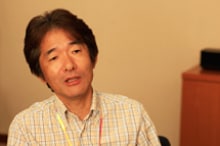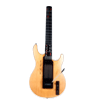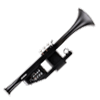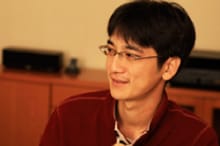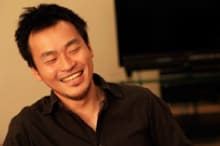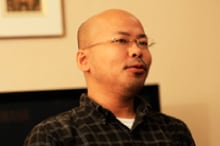YIT-W10 Wireless transmitter for iPod
As if by magic, the speaker system installed in your room is turned on, and music playback begins.
Select songs and adjust the volume right there in your palm.
No need to move from your seat and go near the stereo system.
This kind of smooth operation convenience is made possible by Yamaha's original digital wireless technology "yAired".
A revolutionary idea to free up digital devices from cumbersome connections stood at the beginning.
The end result is a system that transmits high-quality music data without delay or degradation.
|
|||||||||||||||||
|
|||||||||||||||||
|
|||||||||||||||||
|
|||||||||||||||||
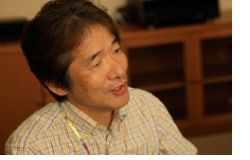 |
— Jazz, R&B, Bossa Nova — in most any genre, the timing is crucial for music to get into a groove. Even with a simple 8-beat, pulling the accent just a tad forward or back can change the whole nuance of a song. When one wants to retain the thrill of the music, data delays in communication are simply not acceptable.
Asahi:"We gave Bluetooth a try, but it turned out to be hopeless. Take for example a guitar. If you strum a chord and then hear the actual clang a beat later, jamming becomes an exercise in frustration. It just won't work. We looked all over for existing solutions, but finally arrived at the conclusion that the only way to go about this was to build something by ourselves. That was the beginning of the long road that led to yAired."
— Mr Asahi, who became the "idea guy" of the project, actually has quite a reputation within Yamaha as an engineer with a flair for coming up with radically new concepts. In 2002, he created the EZ-EG guitar that has lighted switches instead of strings at the neck, allowing even beginners without knowledge of chords to play music. He also was involved in the development of the TENORI-ON, a unique electronic instrument with a 16 x 16 LED button matrix for playing light and sound simultaneously. An underlying theme here is how to free the music from the small number of skilled players, allowing even persons without special skills to have musical fun.
Asahi:"I care about that probably because I myself am pretty hopeless" laughs Mr Asahi. "When I was in middle school, I sweet-talked my parents into buying me a Yamaha classical guitar. Since then, I've been playing it but still not making any real progress. So I naturally thought that it would be nice to have an instrument that anyone can play. By lowering the bar, as it were, Yamaha creates a kind of cycle that in the long run will have positive repercussions for the company as well. With every project that I worked on, that approach has remained the same."
— While struggling with the development of a new wireless communication format, the type of product envisioned by Mr Asahi shifted from musical instrument to portable audio player. 'If we're building a framework for easy session hook-up, why not apply it to something that is even closer to home?' That is the thought that triggered the change in direction.
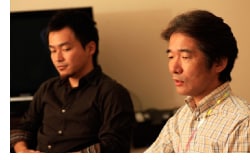 |
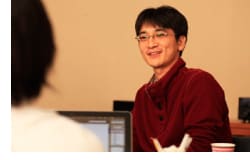 |
As for motivation, Masato Suzuki also had another impetus. While at university, he formed a budding Fusion band, and the thought of wireless communication designed specifically for music use was something that he wanted to pursue even then. "I switched from playing the trumpet to wind synthesizer, and as soon as I plugged in the cable, I noticed that blowing the instrument had just become much harder. There was less freedom of movement, and sometimes I ended up tripping the cable. Therefore one of the things that I thought I'd like to do after being hired by Yamaha was to work on wireless instruments. This was a real motivation for me."
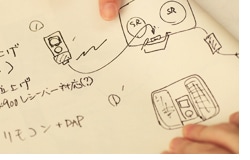 |
As the specifications for yAired gradually took shape, an important event in the industry caused the original concept for a portable audio player that could be used for jam sessions to be temporarily shelved. That event was the introduction of Apple's iPhone with its overwhelming usability and great mass appeal. But of course, Mr Asahi did not give up so easily. Rather, he saw the iPhone platform as an opportunity, since it might be able to make optimum use of the sophisticated yAired approach offering very short delay times. He envisioned a new kind of product, namely a desktop audio system specially geared to the iPhone and iPod. The entire project team was switched from the musical instrument department to the AV equipment division, and continued to work towards the development of this new goal while benefiting from their previous efforts.
Yuichiro Kuzuryu, who has extensive development experience ranging from wireless modules to audio circuitry design, joined the team at this point. While working on electrical aspects of AV receivers, he kept dreaming of a novel kind of breakthrough.
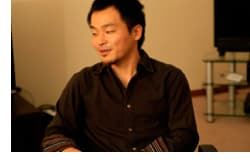 |
— After the team of ambitious young developers had been formed, the cycle of trial and error started again. While retaining the advantages of yAired, usability as an iPhone/iPod peripheral now had to be realized as well. A full year was spent on development, until Yamaha finally released the Portable Player Dock PDX-50 to the world in the autumn of 2008.
Asahi:"A time shift of 12 milliseconds is what only a top-rank drummer would perceive, and that only barely. In a normal hearing situation, such a delay will cause practically no sense of discomfort or lag. When playing a game on the iPhone for example, it is about the same as the interval between touching an element on the screen and hearing the corresponding sound."
— Even when viewing video material on the iPhone or iPod with this system, there is no lip sync problem. Normally, the maximum sound delay considered acceptable for video viewing is about 40 milliseconds (0.04 s). Unlike with Bluetooth or Wi-Fi, the viewer will not experience any stress in this regard, being able to enjoy dynamic, perfectly matched sound via a wireless link. This is a significant advantage.
So, how was this minimization of delay achieved in yAired? Engineer Akihiro Kawata, in charge of wireless design, explains that it had to do with getting back to the essentials, approaching the problem from a fresh angle, and having clearly defined goals. This seasoned wireless professional who was head-hunted from another company joined the team after the PDX-50 was released. The aim at the time was to further improve yAired performance and broaden its range of applications.
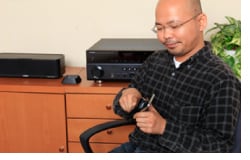 |
— Instead of aiming for perfection from the start, optimising the overall balance to convey the music naturally and without effort was the approach at work here. As Mr Kawata points out, a wireless engineer locked in a struggle to solve tricky detail issues probably couldn't have arrived at Mr Asahi's vision, who sees the bigger picture and gives priority to what the product is all about. Another aspect of yAired is the fact that music data are handled in non-compressed PCM format. This obviously results in more transparent and natural sound quality, but it is also related to the approach of giving priority to the real-time performance aspect.
Kawata:"Compressing music data might be thought to reduce the volume of traffic, but the arithmetic processing load actually increases, due to the encoding and decoding stages. And what's more, the data interpolation required by this process invariably brings with it a degradation of sound quality. So there is almost no advantage to this approach. For yAired we therefore opted to forego the compression step. As a result, when compared to Bluetooth and Wi-Fi, the sound is more detailed, with a rich and glossy high end and complex ambience coming across beautifully. The determination to focus on the music has really paid off, I believe."
— Within the department, there were initially voices in favour of going with Bluetooth because of its high degree of acceptance. But when yAired was demonstrated during repeated in-house tests to achieve perfect video/audio synching with games and movie sources, the doubters were gradually won over. yAired does not represent a departure from the Yamaha tradition of striving for sonic excellence. Rather, it is a challenge that adds a new dimension to the Yamaha concept of values.
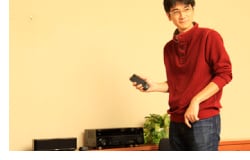 |
— The fruit of these efforts is an impressively simple design, with only two unobtrusive buttons on the oblong PDX-50 body. (Initially Mr Suzuki was against including even these remove “power and” volume buttons.) But the less the user has to worry about, the more the engineers have to accomplish behind the scenes.
Kuzuryu:"To establish a wireless connection, the transmitter first has to tell the iPhone or iPod 'I am a bona fide accessory approved by Apple', in what is called the peripheral authorization process. Only when this is successful, power will be supplied and communication with the speaker system becomes possible. A problem here is the fact that there are many iPhone and iPod models and versions, which all have slight differences in operation. To ensure that our product would work with every model and version took a lot more effort than we had anticipated."
— As a matter of fact, yAired is the only proprietary wireless technology currently approved by Apple Corporation. To obtain approval, high-level experimental proof that the wireless communication does not affect phone operation is required. The team members repeatedly went on overseas trips to have the required tests on their product done by various certification bodies.
Kuzuryu:"The spec requirements posited by Apple are extremely demanding. Most manufacturers sooner or later give up at that stage. yAired continuously monitors the RF signal and adaptively controls the signal strength of the wireless side to allow problem-free coexistence of voice calls and data communication."
— The important thing here is to anticipate a wide range of actual usage scenarios, in order to eliminate various elements that could inconvenience the user. Engineers must use their imagination and expend a lot of effort in areas that are not necessarily very visible. In the end, this is what determines the true value of the product. Enabling song selection and volume adjustment at the device and eliminating cumbersome pairing procedures, these features all were adopted with the standpoint of the user in mind. It is a manifestation of Mr Asahi's unwavering philosophy, and the younger generation of developers has assimilated this way of thinking during their work on the yAired project.
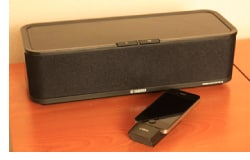 |
Kawata:"The wireless specifications are the same, but an improved antenna design process and other measures such as internal redesign to maximise the distance to any metal parts have resulted in notably better reception performance. For the future, we are looking to further refine the communication algorithms and to make the system even less susceptible to delays, also in an environment where there is a high level of Wi-Fi activity. We are already working on several tangible ideas."
— The fact that a single transmitter can operate multiple devices is another sales point for yAired. One could have for example an yAired compatible desktop audio system in the study, a YSP in the lounge room, and an AV receiver in the home theatre room. Then one might walk throughout the house with the iPhone in one's hand and enjoy seamless music reproduction everywhere. Rather than having to go to the equipment and operate it directly, the equipment moves to one's fingertips, as it were. This again demonstrates the user-oriented point of view espoused by yAired.
Kuzuryu:"The new phenomenon called yAired may bring about various interesting changes also in the home theatre world. For example, by wirelessly sending music data from one's iPod to the AV receiver, the receiver's advanced functions such as HiFi DSP and Cinema DSP can be brought into play to enjoy full 5.1 surround sound. Another possibility that is already being realized is to have a single iPod connect simultaneously to a YSP and a subwoofer. Two formerly separate worlds can intersect and give rise to new and interesting forms of enjoyment."
— Software engineer Suzuki also sees yAired as a platform that should be released to as many developers as possible. He envisions a range of applications that make use of the minimal delay and high sound quality possible with yAired.
 |
— Born out of an idea for real-time jam sessions, yAired has progressed into the world of audio. Devices that handle digital sound by nature allow for a wide range of applications and usage scenarios. This is an opportunity for Yamaha to further expand its horizons. And Mr Asahi will doubtlessly continue to push the boundaries.
Asahi:"Traditional acoustic instruments, digital instruments based on them, high-quality audio systems. Yamaha pursues musical excellence in all three of these channels, which makes us quite unique. yAired can be said to have been born at the cross-section of these three areas. Making music more accessible and open to everyone. I think this is what Yamaha is all about."

| |


